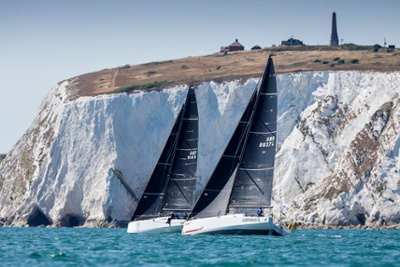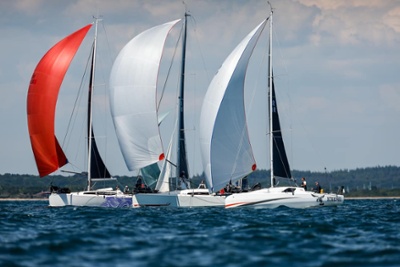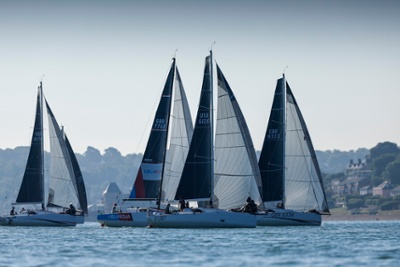
Image credit: James Tomlinson
With interest in doublehanded racing still on the rise and showing no signs of letting up, we wanted to know what the ingredients are for a doublehanded boat to stay safe and sail fast. To gain some insights we conducted a survey of the UK Doublehanded Offshore fleet. We asked about everything from food to sleep to equipment. These are the results.
Survey size
The UK Double Handed Offshore Series in 2022 consisted of 6 races with 4 scores to count and 2 discards. Of the 40 boats entered, 23 boats took part in 4 or more races with the rest making it to the start line only occasionally. Other races took place outside of the UKDHOS series including SSE Round Ireland and Sevenstar Round Britain and Ireland. Our survey collected responses from 16 boats including the top 7 from the UKDHOS series in 2022.
The UK doublehanded fleet is dominated by Sunfasts with approximately 70% of regular competitors comprising the 3200, 3600 and 3300. Our surveyed sample is slightly more Sunfast biased at 81%.
Boat model
|
Boat model |
Number of respondents |
|
Sunfast 3200 |
4 |
|
Sunfast 3300 |
6 |
|
Sunfast 3600 |
3 |
|
Other (J109, JPK10.80, X332) |
3 |
Sails
Hanks vs Foils
We asked people whether they have a bolt rope or sliders on their mainsail and hanks or a forestay foil for their jibs. This decision comes down to aerodynamic efficiency vs ease of handling. A luff foil effectively increases the working sail area and creates less disturbance compared with hanks. Conversely, hanks give the ability to hoist or drop the jib from the cockpit without worrying about pre-feeders or the risk of the sail being dragged overboard if it is not tied down. For a mainsail the handling consideration is perhaps not so crucial as the sail is raised and lowered less frequently than a jib. The choice may also be pre-determined by the style of the mast.
Headsails
- 56% luff foil
- 38% hanks
- 6% furler
Mainsail
- 75% bolt rope
- 25% slides
We were surprised to see the majority of respondents opting for a luff foil over hanks. While this could be expected in a fully crewed fleet, it is interesting that doublehanded boats are not always favouring the robustness of hanks.
Headsails

Image credit: Paul Wyeth
We asked about upwind sail inventory and particularly reefing headsails. A reefable jib gives the ability to reduce sail area faster and easier than changing jibs. The reefed jib can either be a key component of your sail inventory or provide an alternative to the next jib down. In other words, a boat may carry a J2 that reefs to become their J3 followed by a peel to the J4 in stronger wind, or alternatively carry an additional J3 with the same or similar area to the reefed J2. In this setup the reefed sail helps transition quicker, especially when sailing in changeable conditions or when the stronger breeze is only due to last for a short period.
Results showed that:
- 63% use a reefing headsail which is primarily shared between J2 or J3
- 19% of boats have multiple reefing headsails
The downside of a reefing sail is that it must be built with additional structure to carry the loads in the reefed configuration. Additionally, the stowed excess material at the foot when reefed is likely to suffer excess wear.
Downwind sails

Image credit: Paul Wyeth
We asked about downwind sail inventory with particular interest in the split between symmetric and asymmetric. For VMG downwind running clearly symmetric spinnakers tend to have an edge but again this is a question of sailing performance vs handling. With a symmetric pole and additional sheets and guys, the complexity of manoeuvres is greatly increased compared to an asymmetric setup. Our result show a pretty even split:
- 44% have at least 1 symmetric kite (S2)
- 56% are pure asymmetric
- 50% use a spinnaker staysail
Reaching sails

Image credit: Paul Wyeth
Reaching sails are a topic we explored in greater detail in a previous blog with North Sails. Here we were interested to learn about the prevalence of code zeros and other specialist reaching sails in the doublehanded fleet. The importance of reaching sails is evident by the fact 100% of respondents to our survey have a code zero of some kind, whether masthead or fractional. Often that choice is pre-determined by the mast configuration. Additionally:
- 25% have a jib top (JT) or BR0
- 63% have a genoa staysail (GS)
The jib top in its current form, flying from the sprit on a furler, is relatively new. It appears to be gaining popularity at the moment, partly due to being unpenalised under IRC.
Read our blog about achieving a stable reaching setup here
Autopilots
The autopilot is a crucial component of a doublehanded setup and indeed 100% of respondents have a pilot integrated below deck. 60% of the fleet are using the B&G H5000 system with the other 40% comprising Raymarine, nke and older B&G models. When asked to rate pilot performance the average score was 3/5.
Navigation
From its origins in ocean racing, weather routing has trickled down to all kinds of offshore and coastal racing, giving the ability to analyse weather scenarios and quickly compare strategies. In our survey, 100% of respondents use at least one routing software with 75% choosing Expedition Marine and 25% using Adrena or a combination of both. Other platforms reported include PredictWind, Squid, SailGrib and SimSail.
SF3200 Cora says: Always use Adrena as an input for analysing trends in the weather data, but we often don't end up following the routing line that closely. Love it when the software shows you something you hadn't thought of before.
Electricity
Matching power generation to demand is particularly important when there is such reliance on the autopilot. A blackout can be very bad news for a doublehanded team. Ten respondents provided estimated daily power consumption ranging from 120–216Ah with the average at 161Ah or 1.93kW.
While all respondents use engine charging, other methods are starting to be common in the doublehanded fleet with 69% using at least 1 alternative:
- 63% use fuel cells
- 31% use solar
- 25% use a combination of both
SF3300 Sea Bear says: Fuel cell + solar panel deals with circa 70-80% of needs if weather is sunny in daylight hours.
Tigris SF3600 says: Fuel cells have limited effective life (2 years). Good when they are newish.
Long Distance Races
Many of the races in the UK calendar are no more than 24hrs of coast hopping. For such short stints, provisioning requires little planning and many teams push through with minimal sleep. Longer races such as Round Britain and Ireland or the Transatlantic of course require proper planning. Here we split the survey based on whether respondents had taken part in any races longer than 3 days and asked about food preferences, drinking water, sat comms and watch routines.
Food and water
Simplicity is key and unsurprisingly all respondents used some kind of ready meal for long races. 45% preferred boil in the bag with freeze dried at 36%. Tinned food and homecooked frozen meals account for the rest.
For fresh water, re-useable containers were by far the most popular option used by 75% of all respondents. Built in water tanks are less popular used by 31% and almost always in combination with other options. 13% use a water maker (desalinator).
SF3600 Bellino says: Watermaker saves weight in races longer than 3 days.
Sat Comms
For the longer races only, we wanted to find out about satellite connectivity used for weather downloads and communication. For the 83% of respondents using satellite, the most popular device is the Iridium Go! accounting for 70%. The remaining 25% is Iridium Certus 100, 200 and Skylink.
SF3200 Purple Mist says: The Certus 200 is brilliant for weather and blogging but very expensive to run, both the cost of the packages and the power consumption.
Sleep
Finally, watch routines and rest. On a fully crewed boat it is common to fall into a strict watch routine from day 1 and follow this to the minute throughout the race. Doublehanded typically requires greater flexibility as there will be occasions when both sailors are sharing the workload, either both on deck or because one is looking at the nav or preparing food while the other sails the boat. In our survey 83% stated they had equal sleep but at flexible times of day.
JPK10.80 Mzungu! says: Strict alternating watch routine from day 1. In bad weather strict routine gives way to flexible management.
Conclusion
Doublehanded offshore racing continues to grow and common practices change and develop all the time. This survey gives a snapshot of the UK doublehanded fleet at the time of writing. We hope this has given you some insights into the sport and will perhaps help inform your own decisions when setting up your boat and preparing for your next race.
If you have any questions please feel free to email us at support@upffront.com, or click the link below to start shopping:


